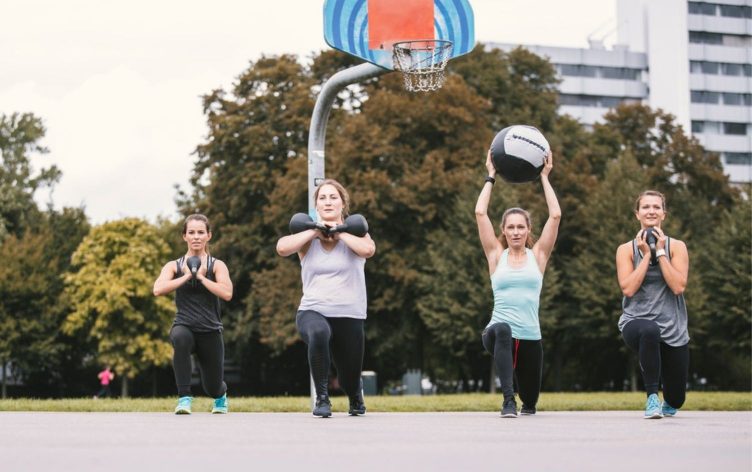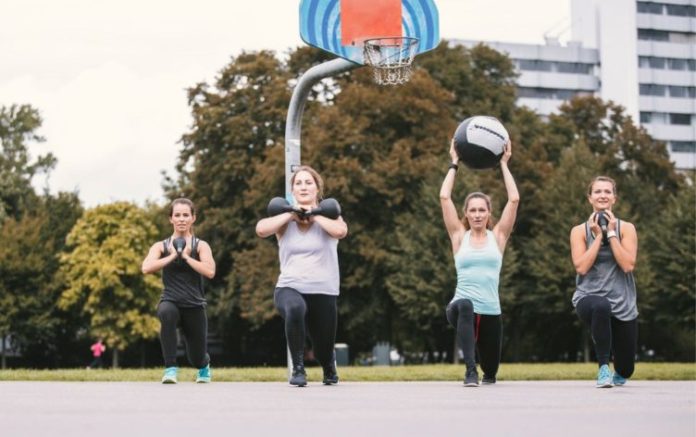
Whether you’ve worked out regularly since playing high school sports or you just started moving more at the request of your doctor, you know exercise benefits your body in all sorts of ways, both visible and invisible.
Not all movement is created equal, though — so if your exercise routine doesn’t involve strength training, well, you might want to reconsider. Fitness experts and the latest research agree: Strength training is a crucial part of any healthy workout routine. In fact, it’s even been added to the American Heart Association’s physical activity guidelines.
But does that mean everyone and their mother should be curling dumbbells and channeling their inner Schwarzenegger? Not necessarily.
WHAT COUNTS AS STRENGTH TRAINING?
If you think strength training requires lugging around dumbbells, kettlebells and barbells only, think again. Any movement that challenges your muscles to work at a significantly higher capacity than their baseline (including simple bodyweight training) is considered strength training, explains Albert Matheny, RD, a certified strength and conditioning specialist and co-founder of Soho Strength Lab in New York City. “Strength training is about increasing the load or demand on your muscles, not about lifting a certain amount of weight,” he adds.
Basically, any movement that makes you stronger — whether it involves actual weights or not — is strength training. “There is no one-size-fits-all formula,” says Jesse Sattler, DPT, a certified strength and conditioning specialist and clinical director of Precision Sports Performance. “Strength training looks different for everyone, depending on their current training or fitness level.”
The purpose is to increase your body’s strength and ability to perform various daily tasks and activities with more ease, says Sattler.
While strength training may look like heavy weight training for a college athlete, it may simply be standing up out of a chair 10 times a day or carrying around the laundry bin for an elderly person, Sattler says. The activity should be challenging enough to overload your muscles so they adapt and grow more capable.
WHAT ARE THE BENEFITS OF STRENGTH TRAINING?
The benefits of having a stronger, more capable body are endless, says Sattler.
Some of the best-known benefits of strength training include:
- Reduced risk of injury in daily activities
- Improved balance and stability
- Increased metabolic rate and calorie burn
- Increased fat loss
- Increased muscle mass
- Improved heart and brain function
- Increased bone density
- Decreased risk of obesity, stroke, heart attack and other medical conditions
In addition, “strength training can actually help you improve your flexibility and mobility for the long-term,” says Sattler. This means you can move and use your joints through a greater range of motion, which becomes increasingly important as you age.
“If you don’t strength train, at some point even reaching up to put something in the cupboard or getting out of the car will become a lot harder,” says Matheny. Strength training builds stronger, more stable older adults, who are less likely to fall. “Even if you do fall, you’ll be more likely to have healthy bone density and less likely to end up with a fracture,” he adds.
Strength training’s benefits aren’t all off somewhere in the distant future, though. “Strength training can drastically change your quality of life,” says Sattler. “It benefits your well-being by supporting self-confidence, healthy energy levels, mental focus and clarity, sleep quality and hormone balance.”
Not to mention, “pretty much anyone who has a physique that people praise does strength training,” Matheny says. “But that’s honestly a secondary benefit to how good it makes you feel.”
YES, EVERYONE SHOULD STRENGTH TRAIN
Though you probably don’t need much more convincing: “Yes, everyone needs to perform some level of strength training,” Sattler says. “It’s non-negotiable.”
If you want to look good, feel good, perform well and prevent injury and illness for life, you must strength train.
And, yes, literally anyone can do it: “There are very few injuries that strength training doesn’t improve both in terms of reducing pain and increasing stability,” says Matheny. Your flavor of strength training may look vastly different than someone else’s (Think: yoga versus CrossFit), but that’s 100% OK.
HOW TO START STRENGTH TRAINING
For most people, getting started with strength training doesn’t involve lifting any weights. In fact, it often begins with using your body weight — or even less than your body weight.
Your first goal: to perform foundational movements, like squats, pushups and pullups well, says Matheny. Often, that involves modifying the moves so you can safely build strength to perform them in their full form. “If you can’t do a pushup from the floor, you’ll start with a modified pushup on a bench or the wall,” Matheny says.
Even as you progress, you can continue to build strength without weights: “You can get wildly strong without ever touching a weight,” Matheny says. Modified pushups become regular pushups, which than can become plyometric or even single-arm pushups.
Of course, if you enjoy lifting weights, you can also incorporate weighted exercises into your routine as you progress, says Matheny.
From there, consistency is key. “Stick with a strength-training program two or three times per week and you will see the value,” says Sattler. (Even the American Heart Association recommends at least two sessions per week.) “Make it a habit and eventually you won’t want to live without it.”
Research published in Current Reports in Sports Medicine suggests just 10 weeks of strength training is enough to experience notable benefits, in terms of physical health and general well-being.
THE BOTTOM LINE
Whether your routine involves weights or not, focus your training sessions on compound movements, in which you move multiple joints and use multiple muscle groups at a time, says Matheny. This way, you get the most benefit for your efforts. Squats, pullups and pushups will always be must-haves.
Still not sure where to start? “Get a good coach, whether it’s a personal trainer, strength coach or physical therapist,” Sattler says. They can analyze your current abilities and create a program that’ll help you reach your goals.







